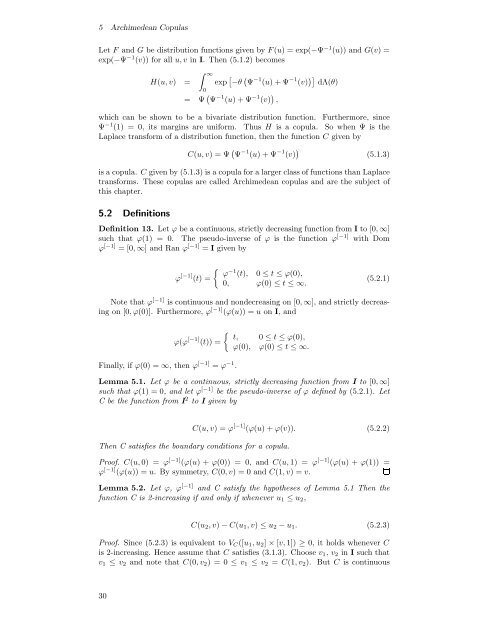Modelling Dependence with Copulas - IFOR
Modelling Dependence with Copulas - IFOR
Modelling Dependence with Copulas - IFOR
Create successful ePaper yourself
Turn your PDF publications into a flip-book with our unique Google optimized e-Paper software.
5 Archimedean <strong>Copulas</strong><br />
Let F and G be distribution functions given by F (u) =exp(−Ψ −1 (u)) and G(v) =<br />
exp(−Ψ −1 (v)) for all u, v in I. Then (5.1.2) becomes<br />
H(u, v) =<br />
∫ ∞<br />
0<br />
exp [ −θ ( Ψ −1 (u)+Ψ −1 (v) )] dΛ(θ)<br />
= Ψ ( Ψ −1 (u)+Ψ −1 (v) ) ,<br />
which can be shown to be a bivariate distribution function. Furthermore, since<br />
Ψ −1 (1) = 0, its margins are uniform. Thus H is a copula. So when Ψ is the<br />
Laplace transform of a distribution function, then the function C given by<br />
C(u, v) =Ψ ( Ψ −1 (u)+Ψ −1 (v) ) (5.1.3)<br />
is a copula. C given by (5.1.3) is a copula for a larger class of functions than Laplace<br />
transforms. These copulas are called Archimedean copulas and are the subject of<br />
this chapter.<br />
5.2 Definitions<br />
Definition 13. Let ϕ be a continuous, strictly decreasing function from I to [0, ∞]<br />
such that ϕ(1) = 0. The pseudo-inverse of ϕ is the function ϕ [−1] <strong>with</strong> Dom<br />
ϕ [−1] =[0, ∞] and Ran ϕ [−1] = I given by<br />
ϕ [−1] (t) =<br />
{ ϕ −1 (t), 0 ≤ t ≤ ϕ(0),<br />
0, ϕ(0) ≤ t ≤∞.<br />
(5.2.1)<br />
Note that ϕ [−1] is continuous and nondecreasing on [0, ∞], and strictly decreasing<br />
on [0,ϕ(0)]. Furthermore, ϕ [−1] (ϕ(u)) = u on I, and<br />
Finally, if ϕ(0) = ∞, thenϕ [−1] = ϕ −1 .<br />
{ t, 0 ≤ t ≤ ϕ(0),<br />
ϕ(ϕ [−1] (t)) =<br />
ϕ(0), ϕ(0) ≤ t ≤∞.<br />
Lemma 5.1. Let ϕ be a continuous, strictly decreasing function from I to [0, ∞]<br />
such that ϕ(1) = 0, andletϕ [−1] be the pseudo-inverse of ϕ defined by (5.2.1). Let<br />
C be the function from I 2 to I given by<br />
C(u, v) =ϕ [−1] (ϕ(u)+ϕ(v)). (5.2.2)<br />
Then C satisfies the boundary conditions for a copula.<br />
Proof. C(u, 0) = ϕ [−1] (ϕ(u) +ϕ(0)) = 0, and C(u, 1) = ϕ [−1] (ϕ(u) +ϕ(1)) =<br />
ϕ [−1] (ϕ(u)) = u. By symmetry, C(0,v)=0andC(1,v)=v.<br />
Lemma 5.2. Let ϕ, ϕ [−1] and C satisfy the hypotheses of Lemma 5.1 Then the<br />
function C is 2-increasing if and only if whenever u 1 ≤ u 2 ,<br />
C(u 2 ,v) − C(u 1 ,v) ≤ u 2 − u 1 . (5.2.3)<br />
Proof. Since (5.2.3) is equivalent to V C ([u 1 ,u 2 ] × [v, 1]) ≥ 0, it holds whenever C<br />
is 2-increasing. Hence assume that C satisfies (3.1.3). Choose v 1 , v 2 in I such that<br />
v 1 ≤ v 2 and note that C(0,v 2 )=0≤ v 1 ≤ v 2 = C(1,v 2 ). But C is continuous<br />
30
















